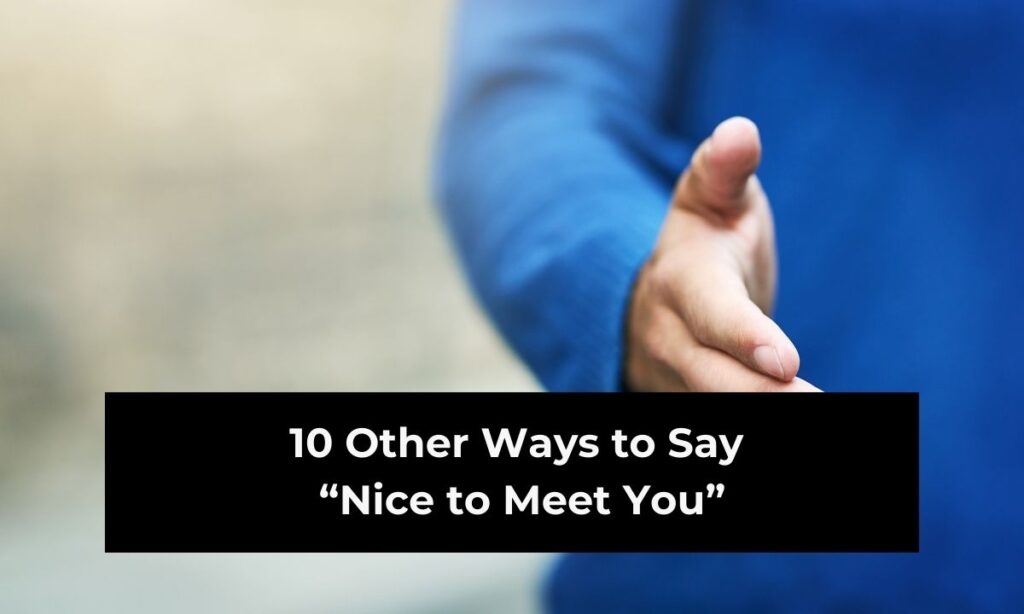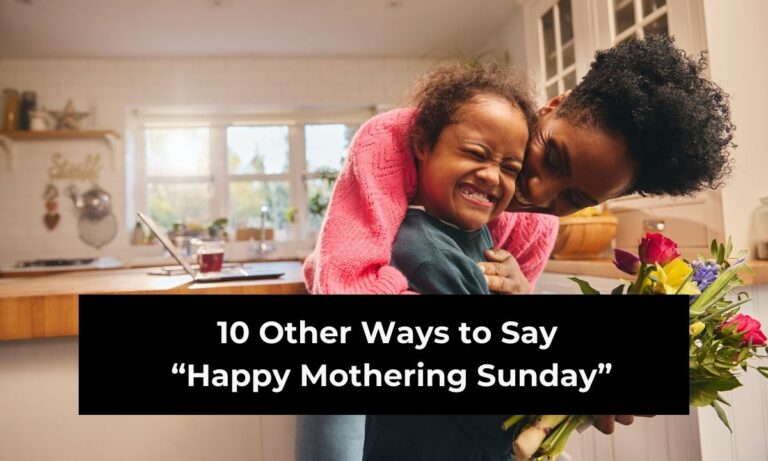When you meet someone new, the first few words you say can set the tone for the entire interaction. Saying “Nice to meet you” is polite and universally understood, but sometimes you might want to stand out a little more. Whether you’re networking, starting a new job, attending a social gathering, or meeting someone online for the first time, having a few alternatives in your back pocket can help you leave a stronger impression.
You’ve probably noticed how certain people have a way of making others feel instantly comfortable. Often, it’s because they know how to express themselves in a way that feels warm, genuine, and memorable. Using creative alternatives to “Nice to meet you” can show that you’re approachable, confident, and truly interested in the person you’re speaking with.
Think about the times you’ve been introduced to someone new. If they said something more personal than the usual “Nice to meet you,” didn’t it feel a bit more meaningful? That small shift in language can make a lasting impact and even spark deeper conversation. By varying how you greet people, you’re not only being polite—you’re also creating connection and showing personality.
This article will walk you through 10 other ways to say “Nice to meet you” that are conversational, professional, and adaptable to different situations. Each phrase comes with examples, explanations, and guidance on when to use it. Whether you’re writing an email, introducing yourself at an event, or hopping on a video call, you’ll find an option that feels right for you.

By the end, you’ll have a collection of fresh, thoughtful ways to greet someone new—phrases that go beyond the standard line and help you build stronger, more authentic connections.
1. “It’s a pleasure to meet you”
This is one of the most timeless alternatives to “Nice to meet you.” It sounds slightly more polished and formal, which makes it a great choice for professional settings like job interviews, client meetings, or industry events.
When you use “It’s a pleasure to meet you,” you’re signaling respect and appreciation for the other person’s time. The word “pleasure” feels genuine and communicates warmth, while still maintaining professionalism.
You might use this phrase during a handshake at a networking event or at the beginning of an introductory email. For example:
- “It’s a pleasure to meet you. I’ve heard great things about your work.”
- “It’s a pleasure to meet you. I look forward to collaborating on this project.”
This expression works well when you want to strike a balance between friendly and formal. It’s not overly casual, yet it doesn’t feel stiff. People often appreciate the sincerity behind it, especially when you deliver it with a smile or pair it with a thoughtful compliment.
The beauty of this phrase is that it fits almost anywhere. Whether you’re in a corporate boardroom or a casual networking mixer, “It’s a pleasure to meet you” instantly sets a positive, respectful tone.
2. “I’m glad we finally met”
Sometimes, you’ve heard about someone before meeting them. Maybe they’re a colleague you’ve only emailed, a mutual friend you’ve been told about, or even a connection from social media. In those cases, “I’m glad we finally met” feels authentic and personal.
This phrase works because it acknowledges that the meeting was anticipated. It makes the other person feel important, as though you’ve been looking forward to this introduction. It’s a subtle way to show appreciation for the connection.
For example:
- “I’m glad we finally met. I’ve been looking forward to putting a face to the name.”
- “I’m glad we finally met. I’ve heard so many wonderful things about you.”
The word “finally” adds a sense of relief and enthusiasm, almost like checking something meaningful off your list. It’s especially effective when you want to break the ice and show that you value the relationship before it even started.
This phrase is best used in semi-formal or casual situations. It’s warm, approachable, and lets the other person know that their reputation or connection precedes them.
3. “It’s great to connect with you”
In today’s digital-first world, many of your introductions might happen virtually. If you’re meeting through email, video call, or a professional networking site, “It’s great to connect with you” is a natural and versatile alternative.
The word “connect” feels modern and adaptable. It works equally well for professional networking, new friendships, or even casual acquaintances. It also emphasizes the idea of building a relationship rather than just meeting once.
For example:
- “It’s great to connect with you. I’ve been following your work online.”
- “It’s great to connect with you. I’m excited to see how we can collaborate.”
This phrase has a collaborative undertone. It’s not just about the initial meeting—it’s about what comes next. When you use it, you’re showing that you’re open to communication and opportunities in the future.
“It’s great to connect with you” also fits perfectly in written communication, like LinkedIn messages or emails. It comes across as professional yet approachable, making it an excellent choice when you want to leave a good impression without sounding too formal.
4. “I’ve been looking forward to meeting you”
This phrase adds a layer of anticipation and excitement to your introduction. It suggests that you didn’t just stumble into the meeting—you were genuinely eager for it.
When you say “I’ve been looking forward to meeting you,” you’re giving the other person a compliment. You’re telling them that they were on your radar and that you value the opportunity to connect.
Here are a couple of examples:
- “I’ve been looking forward to meeting you. I admire the work you’ve done in this industry.”
- “I’ve been looking forward to meeting you. Thank you for making time today.”
This phrase works especially well in professional settings where you want to show enthusiasm without going over the top. It can also be used in social situations, particularly when you’ve been introduced through a friend or mutual connection.
What makes this line so effective is its positivity. It sets the tone for a productive, warm conversation and makes the other person feel appreciated before the interaction even begins.
5. “So nice to finally meet you in person”
In a world where so many connections start online, there’s something refreshing about finally meeting face-to-face. This phrase captures that moment perfectly.
You can use it when you’ve exchanged emails, video calls, or social media messages with someone and are just now meeting them physically. It acknowledges the history of your connection and makes the encounter feel more meaningful.
For example:
- “So nice to finally meet you in person after all those calls.”
- “So nice to finally meet you in person. I feel like we already know each other.”
This phrase is particularly warm and personable. It helps bridge the gap between digital communication and real-life interaction, making the meeting feel special.
Because of its casual yet respectful tone, it’s well-suited for both professional and social environments. Whether you’re meeting a new colleague at a conference or a long-distance friend you’ve only chatted with online, it’s a natural way to express excitement and sincerity.
6. “I’ve heard so much about you”
This alternative works beautifully when someone has spoken highly of the person you’re meeting. It conveys curiosity, appreciation, and a sense of anticipation.
By saying “I’ve heard so much about you,” you’re giving the other person a compliment without even realizing it. You’re letting them know they’ve made an impression before you even met.
For instance:
- “I’ve heard so much about you. It’s great to finally meet.”
- “I’ve heard so much about you. Everyone speaks so highly of your work.”
This phrase naturally invites conversation. Often, the other person will ask, “Oh really? What have you heard?”—which gives you an easy opening to share positive comments or mutual connections.
It’s best used in introductions facilitated by a third party, like meeting a friend’s colleague, a mentor’s recommendation, or a family member’s acquaintance. Just be sure to keep your tone light and genuine so it feels authentic, not rehearsed.
7. “I’m delighted to meet you”
If you want to add a touch of charm and formality, “I’m delighted to meet you” is a perfect choice. The word “delighted” feels both professional and enthusiastic, making it suitable for occasions where you want to express respect without being overly casual.
This phrase is excellent for interviews, formal networking events, or first meetings with clients. It communicates warmth while also keeping the tone polished.
Examples include:
- “I’m delighted to meet you. I’ve been following your career for a while.”
- “I’m delighted to meet you. Thank you for taking the time to connect.”
“I’m delighted to meet you” works especially well in industries where courtesy and etiquette are highly valued. It leaves a refined impression while still making the other person feel welcome.
It’s a versatile option too—you can use it both in writing and in spoken introductions. It shows that you’re genuinely pleased by the encounter and helps you stand out from the usual “Nice to meet you.”
8. “What a pleasure to meet you”
This expression is very similar to “It’s a pleasure to meet you,” but it feels slightly warmer and more conversational. Adding “What a” gives the phrase a natural enthusiasm, almost like you’re pleasantly surprised by the introduction.
You might use this phrase in social or semi-formal settings. It has a friendly tone that works well at parties, networking mixers, or even casual business meetings.
Examples include:
- “What a pleasure to meet you. I’ve heard great things about your work.”
- “What a pleasure to meet you. I’m glad we had the chance to connect.”
This phrase has an elegant yet approachable feel, making it versatile for both personal and professional introductions. It communicates sincerity and warmth while still being polished enough for formal situations.
The key to using it effectively is delivery. Pair it with a smile, a handshake, or a friendly tone of voice, and it will feel genuine and welcoming.
9. “It’s wonderful to meet you”
If you want something that feels heartfelt and uplifting, “It’s wonderful to meet you” is a great choice. The word “wonderful” adds extra warmth compared to “nice” or “pleasure.”
This phrase works especially well in social settings, such as meeting a friend’s family, attending a celebration, or being introduced to someone in a relaxed environment. It’s less formal than “delighted” but still conveys genuine appreciation.
For example:
- “It’s wonderful to meet you. I’ve been hearing so much about this event.”
- “It’s wonderful to meet you. Thank you for inviting me along.”
This greeting feels personal and authentic. It gives the impression that you’re genuinely happy to make the connection. When delivered with enthusiasm, it can set a friendly, open tone for the conversation that follows.
10. “I’m excited to meet you”
This is one of the most energetic alternatives you can use. Saying “I’m excited to meet you” conveys enthusiasm, positivity, and genuine interest. It’s especially fitting if you’ve been anticipating the meeting for professional or personal reasons.
For example:
- “I’m excited to meet you. I’ve admired your work for years.”
- “I’m excited to meet you. I’ve been looking forward to this conversation.”
This phrase works well in collaborative or creative environments, where enthusiasm is valued. It can also be a good opener for networking events or new partnerships where you want to signal that you’re eager to engage.
The key is to keep your tone balanced. If you deliver it too strongly, it might feel overwhelming. But with the right tone—genuine and enthusiastic—it leaves a strong, positive impression.
Conclusion
Saying “Nice to meet you” is always polite, but it can feel a little overused. By choosing alternatives, you give yourself the opportunity to sound more authentic, approachable, and memorable. Whether you prefer the professional charm of “It’s a pleasure to meet you,” the modern friendliness of “It’s great to connect with you,” or the enthusiastic warmth of “I’m excited to meet you,” each phrase helps you create stronger connections.
The key is to match your choice of words to the situation. A formal business setting might call for “I’m delighted to meet you,” while a casual gathering could be the perfect time for “It’s wonderful to meet you.” No matter the setting, your goal is to make the other person feel valued and comfortable.
By having a variety of alternatives ready, you’ll not only avoid sounding repetitive but also stand out in people’s minds. The right introduction can spark a conversation, leave a lasting impression, and open doors to new opportunities.
So next time you meet someone new, try one of these fresh alternatives. You might be surprised at how much more natural, engaging, and memorable your introductions become.
FAQs
1. Is it rude not to say “Nice to meet you”?
Not at all. As long as you use a polite alternative, people will appreciate your effort to personalize the greeting.
2. Which phrase is best for professional settings?
“It’s a pleasure to meet you” and “I’m delighted to meet you” are safe and polished options for formal occasions.
3. Can I use these alternatives in emails?
Yes. Phrases like “It’s great to connect with you” or “I’ve been looking forward to meeting you” work especially well in written communication.
4. What should I say if I’ve already met the person online?
Try “So nice to finally meet you in person” to acknowledge your previous connection and make the in-person meeting feel special.
5. How can I make my introduction feel more genuine?
Pair your greeting with eye contact, a smile, and, when appropriate, a personal compliment or acknowledgment of why you’re glad to meet them.





